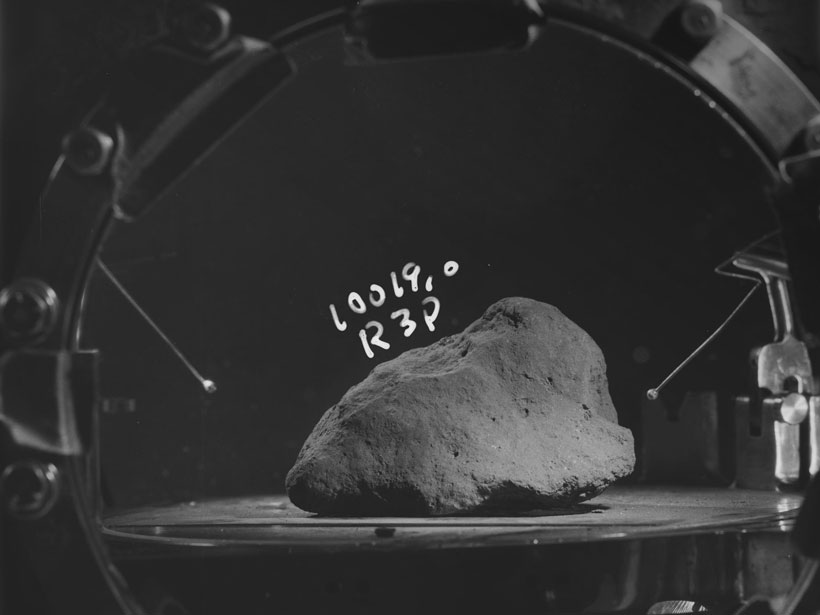Scribbled in ballpoint pen on an equipment bay panel in pilot Michael Collins’s handwriting are the words
……..Spacecraft 107, alias Apollo 11, alias “Columbia.”
……..The Best Ship to Come Down the Line.
For all that we celebrate the feat of engineering of the first Moon landing, it hits us hardest when we remember how human it all was.
If it’s hard to imagine walking on the Moon, we can easily imagine Collins’s immense pride as he rode the USS Hornet to Hawaii after splashdown, uncapping his pen to leave behind a mark that commemorated this wild mission. (Technology later revealed it was twice the pride: Three-dimensional imaging of Columbia, Apollo 11’s command module, by the Smithsonian Institution in 2016 revealed that Collins came back to the ship later, likely while he was in quarantine at the Johnson Space Center, and wrote over his note again to preserve it.)
AGU has the honor of celebrating the 50th anniversary of the first Moon landing along with our own Centennial.
AGU has the honor of celebrating the 50th anniversary of the first Moon landing along with our own Centennial. Join us at the National Archives in Washington, D.C., on 17 July when AGU will be sponsoring a geology panel discussion, “Small Steps and Giant Leaps: How Apollo 11 Shaped Our Understanding of Earth and Beyond.”
We also celebrate the legacy of Apollo in the pages of Eos. Our cover story looks at the science that came out of the 382 kilograms of Moon rocks hauled back by the astronauts. As recently as this past January, scientists announced a new discovery from the Apollo 14 mission: zircon grains common to Earth but unique to the Moon—which is to say, lunar-roving astronauts may have brought back an Earth meteorite!
NASA researchers had the foresight not to put all these alien treasures under the microscope as soon as they got their hands on them—a portion was held back and protected from our atmosphere so that today’s scientists could use modern technology on untouched specimens. We know we’re not alone in our excitement at what they might discover about our closest planetary neighbor.
While we reflect on how those space missions changed so much about the way we view our place in the universe, we continue to be inspired by new opportunities for exploration. Telepresence, wherein astronauts in orbit around the Moon or Mars would guide robots on the ground, is shaping up to be the next big thing in space exploration. Meanwhile, experts here on Earth are first guiding this technology underground. Read about a team testing robots that can autonomously navigate through flooded mines. The idea is less romantic, perhaps—there’s no one to call back that the Eagle has landed—but sending in robots to such treacherously dangerous terrain is likely the best way to keep pushing our boundaries of exploration.
Our forays into space technology have led us to new adventures on Earth as well.
Our forays into space technology have led us to new adventures on Earth as well. Geoid anomaly maps created by satellite observations have revealed strangeness in the Indian Ocean. Read about the Indian research team that is on the hunt for the “missing mass” that will explain the largest geoid anomaly in the world. Theories abound: Is the anomaly due to structural undulation in the core-mantle boundary? Seismic low-velocity anomalies in the upper mantle? A “slab graveyard” in the lower mantle? To find out, the team headed to the source and deployed seismic sensors to record data for a year. We eagerly await their results.
Behind all science is the excitement of exploration and the thrill of discovery. In every issue, Eos dedicates its final page to such adventurers with Postcards from the Field. This month we hear from a team hand digging paleoseismic trenches in the Teton Range.
We urge you all to keep exploring, keep discovering—and send us a postcard!
—Heather Goss (@heathermg), Editor in Chief
Citation:
Goss, H. (2019), Spacecraft 107’s big trip, Eos, 100, https://doi.org/10.1029/2019EO127277. Published on 01 July 2019.
Text © 2019. AGU. CC BY-NC-ND 3.0
Except where otherwise noted, images are subject to copyright. Any reuse without express permission from the copyright owner is prohibited.
Text © 2019. AGU. CC BY-NC-ND 3.0
Except where otherwise noted, images are subject to copyright. Any reuse without express permission from the copyright owner is prohibited.

